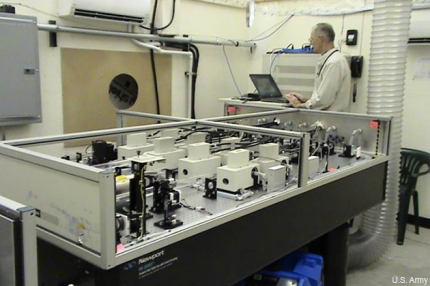ARL, TARDEC work to defeat laser threats that could blind soldiers
Wavelength-diverse lasers, which are difficult to filter out, could be used to blind tank gunners and attack soldiers’ eyesight.

A large, custom-built laser makes up part of the threat simulator.
In conjunction with developing new laser weapons for its ships and vehicles, the military is also looking to protect its own soldiers from laser threats.
As a part of the Army Research Lab’s effort to develop a laser-protection device for the gunner’s primary sight on the M1A2 Abrams tank, the laboratory’s Survivability/Lethality Analysis Directorate has created an advanced laser threat simulation system in collaboration with the Tank Automotive Research, Development and Engineering Center, according to an ARL release.
The M1 Abrams tank saw combat in Desert Storm, Operation Iraqi Freedom, and Afghanistan. Capable of outgunning and withstanding attacks from Iraqi T-72s, the tanks were targeted by insurgents that relied on asymmetric tactics, such as improvised explosive devices and rocket propelled grenades aimed at vulnerable parts of the tanks.
As laser technologies improve, future anti-tank tactics could involve threat lasers used to blind soldiers using magnified direct-view optics, such as the M1’s gunner’s sight. Although these laser systems are not currently commonplace, they may become more prevalent in the future.
"As the threat evolves, at some point our soldiers will likely encounter lasers that are wavelength diverse and very dangerous," Norman Comer, SLAD physicist and team leader at the Electro-Optical Vulnerability Analysis Facility, said in the release. "Our primary concern is to protect soldiers from eye damage and blindness, but it is also our goal to give soldiers an advantage in the field by being able to defeat these kinds of threats."
ARL scientists believe that it might be possible for adversaries to wield wavelength-diverse lasers, which would present a significant defensive challenge. Lasers that operate at a single wavelength – simple laser pointers, for example – can be blocked with filters. Wavelength-diverse lasers, which can operate on several different wavelengths, are much more difficult to block without restricting the entire visible spectrum.
TARDEC’s solution is the development of laser-protection cells that would be incorporated into direct-view optics. The cells are designed to absorb and disperse laser energy across a larger area in the retina, reducing potential damage to eyesight.
SLAD’s contribution lies in its development of a laser threat simulator that could mimic what soldiers might run into on the battlefield, allowing TARDEC to test its solution against what researchers believe to be the most dangerous lasers that could be encountered. The new simulator, developed over the course of two years, represents a worst-case, visible laser threat that can operate at a tactical stand-off range.
"This threat emulator is based on a large laser custom built for us by a laser manufacturer," Comer said. "We use this custom laser to 'pump' a dye laser, which we developed, in-house. Together, they mimic a wavelength-diverse laser. The final output is designed to simulate the postulated threat in terms of its energy, pulse width, beam size and divergence."
SLAD expects to use the eye-protection technology against the long-range simulator this summer.
The military has begun investing in direct energy weapons designed to take down drones or conduct crowd control. The Marine Corps has been investigating the use of a vehicle mounted anti-drone laser, while the Navy is expecting to deploy its first ship-based laser this summer. Defense futurists are also envisioning the use of directed energy systems on future aircraft, allowing them to intercept incoming missiles or projectiles.
NEXT STORY: Watch: DARPA unveils guided bullets




